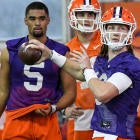It has been college football's dirty little secret for years: Voluntary offseason workouts aren't exactly "voluntary."
Either a coach makes those workouts something more than the name implies, or he holds playing time over the head of those who don't "voluntarily" workout. Sometimes both.
That football culture met the coronavirus this week as programs opened for the first time since college athletics were shut down in March. Most programs will begin voluntary workouts by the middle of the month.
"'Voluntary,' sadly in our college game, has been a very loose term," Oklahoma coach Lincoln Riley said this week. "The reality is there are different institutions in different conferences that allow you to do a different amount or some just look the other way."
Riley did not name names. Voluntary workouts -- a pathway toward actual football returning in 2020 -- were allowed when the NCAA recently let expire a moratorium on all on-campus athletic activities that ended May 31.
For now, coaches and players are reconnecting and interacting after almost three months apart. There's only so much that can be accomplished on Zoom. That contributes to an anxiousness to get back to the football facility. If nothing else, it feels like home, a place to bond and work out again.
It also means a natural insulation from the outside world that goes with that football culture. With no outside interference and perhaps no accountability, that "reality" Riley referred to sometimes can actually include football activities -- installation of the game plan and organized practices, even if they are held in shorts and T-shirts.
For now, footballs aren't supposed to be a part of voluntary workouts. Aside from strength coaches, the football staff isn't supposed to be around. Riley's suggesting that, sometimes, both balls and coaches can be found.
CBS Sports asked several sources whether the temptation would be there to begin practicing football instead of just training for it.
"I'm sure the temptation will be high," said Riley, whose players begin voluntary workouts July 1. "It all comes down to your priorities and what you believe is best. It's unfortunate that that's what it's come to right now, but we have other parts of our year where that's always been an issue. It's well known across coaches and players across the country."
Well known? That's troubling, but that's a reason why the NCAA Manual is 452 pages. Since 1991, major infractions in football programs involving unethical conduct has occurred an average of once every three years.
And that's the ones the NCAA catches. Riley made it clear that breaking the offseason workout rules may be as common as breaking the huddle.
"I think there is always that temptation, but you can't legislate integrity," West Virginia athletic director Shayne Lyons said. "Could there be those [improper] tendencies? I think there always could be, but it's making sure we're abiding by the rules and regulations. I think it's going to be a little bit more difficult with the circumstances we're in."
In normal times, football programs are allowed to open up for voluntary workouts nine weeks before the official beginning of fall camp. (Camps typically begin late July or early August.) One of those weeks must be "discretionary" where strength coaches are present only for supervision and safety.
That's essentially where we are right now. These current workouts are opening up anywhere from 6.5-7.5 weeks from the beginning of fall camps. Those strength coaches will be around to spot and supervise. But football staff? A no-no.
"Suggested workouts will be posted," explained Lyons, who is also chair of the NCAA Football Oversight Committee. "Also, if a kid decides not to show up -- compared to mandatory workouts -- there can't be any repercussions. The kid says, 'You know what? I didn't feel like getting up at 8.'"
The reason players want to be back is the same reason most of them will be back: playing time. A player doesn't have to show up, but a coach doesn't have to play him, either.
If the past history of that culture is an indicator, his absence will be noted.
"It's a fine line between required and voluntary," Lyons said. "You remember the old, 'wink-wink.'"
"I'll personally make it clear to all our student-athletes that it's voluntary," said Washington State AD Pat Chun. "I fully understand where that belief is coming from, [but] if there are one or two kids who don't feel comfortable, they'll have my phone number. They can call me."
That oversight committee will submit recommendations to the NCAA Council for when football-related activities can begin on June 17. The most likely starting point will be mid-July, giving schools that start Aug. 29 approximately six weeks to prepare.
By then, there will be the usual coach consternation over opponents getting head starts. Riley reiterated this week that he doesn't mind starting late with voluntary workouts. It's more about safety and science.
But coaches everywhere wouldn't be where they are if they didn't try to seek every competitive advantage.
Forget $100 handshakes, some of it is mindless stuff: Iowa coach Hayden Fry had the visitors' locker room painted pink to psych out the opposition. There was the Jim Harbaugh satellite camp controversy. He's also taken his teams to Europe during spring practice. Never mind his entertaining recruiting tactics, ranging from a sleepover to cartwheels.
There has long been speculation about the number of "analysts" programs employ. Flopping -- defensive players faking injuries to slow down a high powered offense – is on the radar of the NCAA Football Rules Committee.
But coaches like Riley will continue to freak out when talking about their peers taking liberties during offseason workouts. Maybe the next step is ratting them out.
"Coaches across the country have definitely tried to find different ways to be productive in this time," Penn State quarterback Sean Clifford said. "They're chomping at the bit to get back to their team, as am I."
















